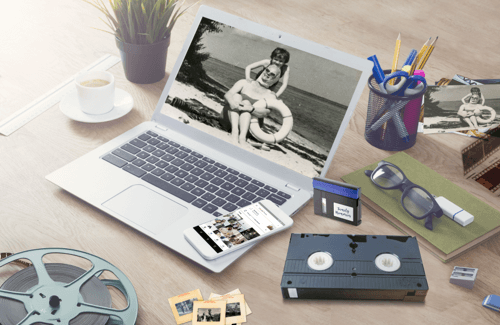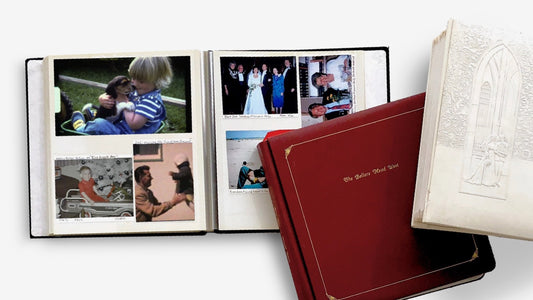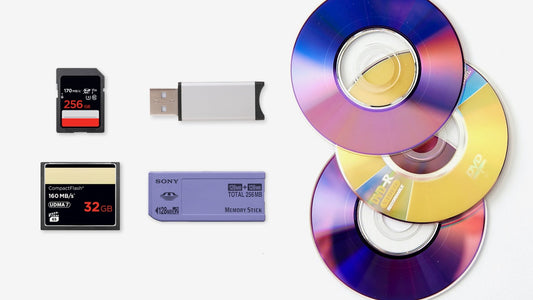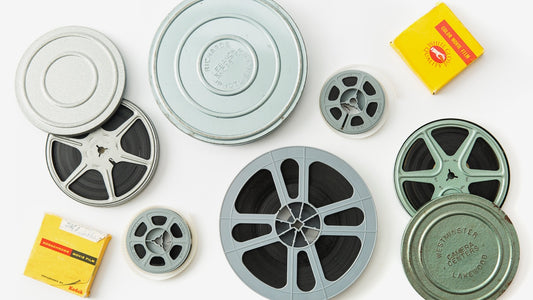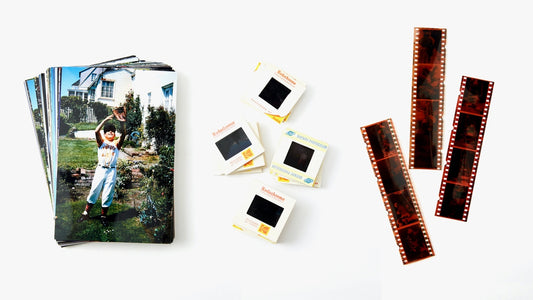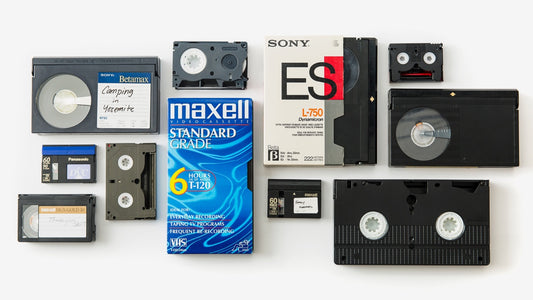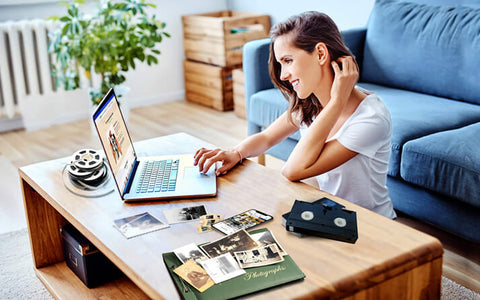The best part of digitizing your home movies isn’t just about saving them; it’s about bringing them back to life. For years, those memories have been trapped in a box, on a format that’s nearly impossible to watch. But once they’re converted to digital files, they become living history again. You can share a clip of your parents’ wedding on their anniversary, watch your own childhood birthday parties with your kids, and send precious family moments to relatives across the country with a single click. The choice to restore old video tapes transforms forgotten moments into shared experiences, reconnecting your family with its most cherished memories.
Key Takeaways
- Your Tapes Have an Expiration Date: Magnetic tapes naturally degrade over time, especially when stored in hot or humid places. Digitizing your home movies is the only way to stop this decay and permanently save your memories before they fade for good.
- Assess the Risk Before You DIY: While converting tapes yourself is possible, it requires the right gear and risks damaging irreplaceable footage. If your memories are priceless or the tapes show any signs of wear, a professional service is the safest bet for a high-quality result.
- Protect Your New Digital Memories: Once your videos are digitized, the job isn't quite done. Create a reliable backup plan by keeping at least three copies of your files on two different types of storage (like an external hard drive and a cloud service) to ensure they're safe for generations to come.
Why Are Your Old Tapes Fading?
If you have a box of old home movies tucked away in a closet, you’re holding onto priceless memories. But here’s something you might not know: those tapes are slowly breaking down. Video tapes, whether they're VHS, MiniDV, or 8mm, weren't built to last forever. They're made of magnetic tape, which naturally starts to degrade after about 15 years. The picture can get fuzzy, the colors can fade, and the sound can warp. It’s a quiet process, but it’s happening.
The good news is that you can stop this process in its tracks. The first step is understanding what you’re up against. By learning to spot the warning signs of damage, identifying your tape formats, and understanding how storage conditions play a role, you can figure out the best way to save those memories. Whether you decide to tackle the project yourself or hand it over to professionals, a little knowledge goes a long way in making sure your family’s history is preserved for years to come.
Warning Signs: Is Your Tape Damaged?
Before you pop an old tape into a player, give it a quick inspection. You can often spot trouble before you even press play. Look for visible signs of mold, which can appear as white or black powdery spots on the tape itself. Dust, dirt, and grime on the casing or tape can also cause playback issues. Check the plastic shell for cracks or damage, as this can prevent the tape from playing correctly. If you notice a musty or vinegary smell, that’s another red flag. These issues are often caused by poor storage, especially in damp basements or hot attics.
A Quick Guide to Common Video Formats
Do you know your Betamax from your Hi-8? Identifying your tapes is the first step toward preserving them. The most common format is the classic VHS tape, but you might also have smaller VHS-C tapes that were used in camcorders. Other popular formats include Betamax, Hi-8, Digital8, and MiniDV. Each has a unique size and shape. Don't worry if you have a mixed collection; a professional video transfer service can handle a wide variety of formats, ensuring every memory, no matter the tape type, is carefully digitized.
How Time and Storage Affect Your Tapes
Time and environment are the biggest enemies of old video tapes. The magnetic particles that hold your video and audio information can lose their charge over time, leading to a faded picture and weak sound. Storage conditions make a huge difference. Tapes kept in damp, humid areas like basements are prone to mold growth, which can permanently damage the tape. Extreme temperature changes, like those in an attic or garage, can cause the tape to become brittle and snap. The best way to slow down this decay is to store your tapes in a cool, dry place with stable temperatures.
When to Call in the Professionals
While tackling a project yourself can be rewarding, restoring delicate video tapes isn't always a simple weekend task. If your tapes are showing signs of damage, are particularly old, or if the memories they hold are simply too precious to risk, it’s time to consider a professional service. Deciding between a DIY approach and professional restoration often comes down to the condition of your tapes and your comfort level with handling the process. Experts have the tools and experience to safely handle fragile media and produce a high-quality digital copy that you can cherish for years to come.
They can spot issues you might miss—like subtle mold growth or a brittle tape—and have the right solutions to fix them without causing more harm. A home VCR, for example, can easily chew up a delicate tape, destroying a memory forever. It's about entrusting your history to someone who does this every day, ensuring those irreplaceable moments are preserved perfectly. Think of it as calling a plumber for a tricky leak instead of risking a flood; sometimes, the experts are worth it for the peace of mind alone. When the stakes are this high, professional help is the safest bet.
What a Professional Service Does
A professional service does more than just convert your tapes. They are specialists in media preservation. Using advanced equipment and techniques, they work to achieve the best possible results, often restoring color and clarity you thought was lost forever. When you hand over your collection, you’re trusting a team to carefully inspect each tape, clean it using methods that won't cause further damage, and repair minor issues before the transfer even begins. This careful preparation is a key step in a high-quality video transfer and is something often overlooked in a home setup. They handle everything, ensuring your memories are treated with the care they deserve.
The Tools and Tech They Use
The reason professionals can achieve such great results comes down to their gear. They use advanced scanners and video transfer technology that ensures better resolution, color correction, and sound stabilization than most consumer-grade equipment can offer. This isn't about hooking up an old VCR to a laptop; it's about using specialized hardware and software designed specifically for archival purposes. For different formats, like old reels, they use dedicated film transfer machines that capture the footage frame by frame. This technology allows them to pull the best possible image from the original tape, creating a digital version that’s often clearer and more vibrant than the original.
Understanding the Cost and Value
It’s true that professional services come with a cost, but it’s helpful to think of it as an investment in preserving irreplaceable moments. The price often reflects the time, expertise, and technology required to do the job right. When you factor in the cost of buying your own equipment, the time you'll spend learning the process, and the risk of damaging a tape beyond repair, a professional service can be a very practical choice. The value isn't just in the final digital file; it's in the peace of mind that comes from knowing your memories are in safe hands. Services that handle all kinds of media, from tapes to photo albums, provide a one-stop solution for your entire archive.
What to Expect from a Pro Restoration
When you send your tapes to a professional, the process is straightforward and designed to keep your media safe. First, your tapes are inspected to assess their condition. Then, they are carefully cleaned and prepared for digitization. The transfer itself is done using high-end equipment to ensure a stable, high-quality capture. After the transfer, you’ll receive your memories back in a modern, easy-to-use format, like a digital download, DVD, or USB drive. The goal is to provide you with a digital media transfer that is safe, compatible with today’s devices, and ready to be shared with family and friends for generations to come.
Restoring Video Tapes Yourself
Thinking about tackling video tape restoration on your own? It can be a rewarding project if you have the right tools and a bit of patience. Going the DIY route gives you complete control over the process, but it’s important to know what you’re getting into. Professional services use advanced equipment for a reason, and achieving that same level of quality at home requires a significant investment in both gear and time.
Before you start, be honest with yourself about your technical skills and the value of your tapes. If these are one-of-a-kind memories, you might not want to risk damaging them. But if you’re feeling adventurous and ready for a challenge, here’s what you need to know to get started.
The Gear and Skills You'll Need
To restore video tapes yourself, you’ll need more than just an old VCR. The quality of your equipment will directly impact your final digital file. At a minimum, you’ll need a well-maintained VCR, a reliable analog-to-digital video capture device, a computer with enough processing power and storage, and video editing software. Keep in mind that a DIY conversion requires an upfront investment that can sometimes rival the cost of a professional service. You’ll also need the patience to learn the software and troubleshoot any issues that pop up, from tracking errors to audio syncing problems.
A Step-by-Step Guide to DIY Restoration
The restoration process begins long before you hit "record" on your computer. For the best results, you need to focus on getting the cleanest signal possible from the tape itself. The first step is to properly clean the tape and the VCR heads. From there, the process involves three key stages: purifying the video signal using external hardware, capturing the video with a high-quality device, and then doing a final round of filtering in software. The most critical part of this entire workflow is getting the best possible digital transfer from your original tape, as that will be the foundation for any further edits you make.
Common Problems You Might Face
Even with the right gear, you can run into some frustrating roadblocks. Old tapes are fragile and can suffer from a range of issues, including degraded magnetic particles, causing a snowy picture, or audio that’s out of sync. You might also struggle with tracking issues, where lines appear on the screen because the VCR can’t read the tape correctly. More serious problems include physical damage like a snapped tape or the presence of mold. If your tapes have been exposed to moisture, it’s critical to act fast to prevent permanent damage. Trying to play a moldy or damaged tape can ruin both the recording and your VCR.
Know When to Stop and Get Help
It’s important to recognize when a DIY project is in over your head. If you’re dealing with tapes that are physically damaged, brittle, or show any signs of mold, it’s best to stop immediately. Attempting to fix these issues without professional tools can cause irreversible harm. The danger of DIY options is that a simple mistake can lead to a permanently lost memory. If a tape is truly priceless, consider sending it to a professional service. Experts have the specialized equipment and clean-room environments needed to safely handle and repair fragile media, giving your cherished memories the best chance of survival.
What to Do With Damaged Tapes
Discovering that a treasured family video tape is damaged can feel devastating. That box in the attic or basement holds so much more than plastic and magnetic tape—it holds birthdays, holidays, and voices of loved ones you might not hear anywhere else. So when you pull out a tape and find it covered in white spots, warped from moisture, or even snapped, it’s natural to feel a sense of panic. Before you lose hope, know that many common issues can be addressed, especially with professional help. The key is to correctly identify the problem and take the right steps to prevent further harm.
Trying to fix a damaged tape yourself can often make things worse. A VCR is an unforgiving machine, and feeding it a compromised tape can lead to the magnetic tape being chewed up, permanently destroying your footage. Even seemingly simple issues like dust and debris can cause scratches and signal loss if not handled properly. More serious problems like mold not only threaten your video but can also pose a health risk. This is where understanding the type of damage becomes crucial. Whether you’re dealing with a bit of dust or more serious damage from a flood, the following steps will help you assess the situation and figure out the best path forward to safely preserve your memories for years to come.
Identifying Different Types of Damage
First, give your tape a careful visual inspection. You might see obvious physical damage, like a cracked or broken cassette shell, or a tape that is tangled or snapped. Other signs of trouble can be more subtle. Look for white or black powdery spots, which indicate mold growth. You might also notice dirt, dust, or a gritty residue on the tape itself. Damage from poor storage or water can leave behind stains or a warped appearance. If you see any of these red flags, resist the urge to pop the tape into a VCR. Playing a damaged tape can permanently ruin the recording and may even break your player. The safest first step is to set it aside for a professional video transfer service to evaluate.
How to Handle Mold and Moisture
Mold is a common enemy of old tapes, especially those stored in damp, dark places like basements or attics. Moisture and time create the perfect environment for mold to grow, appearing as white or dark spots on the tape reel. It’s crucial to handle moldy tapes with care, as the spores can be a health hazard. Don’t try to clean them yourself. Wiping the tape can grind the mold deeper into the magnetic surface and spread spores into the air. The best course of action is to isolate the affected tape in a sealed bag to prevent it from contaminating other tapes in your collection. Then, seek out a professional service that has the proper safety equipment and cleaning solutions to treat the mold without destroying your memories.
Can Severely Damaged Tapes Be Saved?
It’s amazing what can be recovered from tapes that look like a lost cause. Tapes that have been in a flood, exposed to fire and smoke, or even snapped in two can often be saved. The most important thing to do with a water-damaged tape is to act quickly. If a tape gets wet, place it in a sealed plastic bag to keep it from drying out, which can cause the delicate tape layers to stick together permanently. For a physically broken tape, gather all the pieces you can find. While there’s no guarantee, professional technicians have a high success rate with these kinds of repairs. They can often salvage precious footage from even the most challenging situations, making a professional film transfer a worthwhile investment.
How Professionals Treat Damaged Tapes
When you send a damaged tape to a professional service, it goes through a careful recovery process. Technicians work in a controlled environment using specialized tools that you just don’t have at home. They might start by carefully disassembling the cassette to access the tape itself. For mold, they use special solvents and gentle techniques to clean the tape by hand. If the tape is snapped, they can precisely splice it back together. For a broken shell, they can move the tape into a new, functioning cassette. These experts use advanced equipment and proven methods to stabilize your media, ensuring they can get the highest quality digital transfer possible. This careful, hands-on approach is why YesVideo is trusted to handle these irreplaceable memories.
How Your Tapes Become Digital Memories
Ever wonder what actually happens to your tapes after you send them off to be digitized? It’s not just a simple copy-and-paste. Transforming a fragile, physical tape into a lasting digital file is a careful, multi-step process that blends technical skill with a gentle touch. Each step is designed to pull the best possible quality from your original recording, ensuring the final video is a clear, vibrant, and shareable piece of your family’s history. From the moment your tapes arrive, they’re handled by experts who know exactly how to treat these irreplaceable memories. Let’s walk through the journey your home movies take from a dusty box in the attic to a digital keepsake you can enjoy forever.
First Look: Assessing Your Tapes
The first thing that happens is a thorough inspection. Before any machine is turned on, a technician carefully assesses the physical condition of each tape. They look for signs of wear and tear, like a brittle or snapped ribbon, as well as environmental damage from mold or moisture. This initial check is crucial because the state of your tape determines the entire approach. A pristine tape might be ready for transfer right away, while a damaged one needs special attention first. This is where the decision between a DIY project and a professional video transfer becomes clear; professionals have the experience to spot potential issues that could ruin a tape in a standard VCR and know exactly how to proceed safely.
Cleaning and Prepping for Transfer
Once assessed, your tapes are meticulously cleaned and prepped. Over the years, dust, dirt, and microscopic debris can settle on the magnetic tape, leading to static, dropouts, or a fuzzy picture. Professionals use specialized equipment to gently clean the tape’s surface, removing contaminants without damaging the delicate ribbon. If any minor repairs are needed, like fixing a cracked cassette shell or splicing a broken tape, they’re done by hand. This preparation stage is vital for a smooth playback and a clean signal, ensuring the best possible raw material before the actual digitization process even begins. It’s a step that’s often overlooked in at-home setups but makes a world of difference in the final quality.
The Technology Behind Digitization
This is where the real magic happens. Digitization is more than just playing the tape and recording it on a computer. The process involves three key stages: purifying the signal, capturing the footage, and filtering the video. First, the analog video signal from the tape is run through professional-grade equipment that stabilizes and purifies it, correcting jitters and inconsistencies. Next, a high-quality capture device converts that clean analog signal into a digital file. Finally, the raw digital video is often filtered one last time using software to make subtle improvements to color and clarity. This technical workflow ensures the digital copy is a faithful and often improved version of the original.
Ensuring a High-Quality Transfer
The goal of any transfer is to create a digital memory that’s as good as—or even better than—the original tape. Professional services achieve this by using advanced equipment that far surpasses what’s available for home use. Superior technology allows for better resolution, more accurate color correction, and the restoration of faded visuals. While a DIY setup might capture the basic footage, a professional transfer focuses on capturing the nuance and quality of the memory. By carefully managing each step, from assessment and cleaning to the final digital rendering, experts can deliver a final product that’s clear, stable, and ready for you to share with your family for generations to come.
How to Choose the Right Restoration Service
Picking the right service to handle your family's memories can feel like a big decision, because it is. You're not just handing over old tapes; you're entrusting someone with irreplaceable moments. The good news is that knowing what to look for makes the choice much clearer. It’s about finding a partner who values your memories as much as you do and has the right tools and expertise to protect them for the future. Think about factors like their technology, the quality they promise, cost, and how long the process will take. A little research upfront ensures your home movies are in the best possible hands.
What to Look for in a Service
When you start comparing services, pay close attention to the technology and techniques they use. A professional service will have advanced equipment that goes far beyond a simple VCR-to-computer setup. This is what makes a real difference in the final quality of your digitized videos. Professional services use specialized gear to stabilize shaky footage, correct colors that have faded over time, and clean up audio, resulting in a much clearer and more vibrant final product than most DIY methods can achieve. Look for a company that is transparent about their video transfer process and the technology behind it.
Key Features of a Quality Service
So, what does a high-quality result actually look like? It starts with the initial scan. Top-tier services use advanced scanners and transfer technology to capture your footage at the best possible resolution. This means your digital files will be sharp and detailed, not blurry or pixelated. A key feature to look for is color correction. Over the years, the magnetic tape in your videos degrades, causing colors to wash out or shift. A quality service can restore the original richness and balance, making your memories look as vivid as you remember them. This professional touch is especially crucial for older formats like film reels.
Breaking Down the Costs
Understanding the cost is about more than just finding the cheapest option; it's about recognizing the value you're getting. The price of professional restoration often depends on the condition of your tapes and the level of work required. A tape that’s in great shape will cost less to digitize than one that’s damaged or moldy. While it might be tempting to go the DIY route to save money, consider the risk to your one-of-a-kind tapes. Investing in a professional service means you’re paying for expertise, peace of mind, and a high-quality result that honors your memories, whether they're on video or in old photo albums.
How Long Will It Take?
Patience is key when it comes to restoration, as turnaround times can vary. Several factors influence how long the process takes, including the physical condition of your tapes, the number of tapes you have, and the specific restoration techniques needed. A service with a high volume of orders might also have a longer queue. A reputable company will be upfront about their estimated timeline and keep you updated on their progress. Remember, a service that takes the time to carefully handle and process your order by hand is often a sign of quality and care for your precious digital media.
Keep Your Digital Memories Safe
Once your home movies are digitized, the most important work is done—you’ve rescued them from fading into obscurity. But the job isn’t quite finished. Now it’s time to protect those digital files so they can be enjoyed for decades to come. Unlike physical tapes that degrade, digital files can last forever if you store them correctly. Creating a solid plan for storing, backing up, and sharing your newly digitized memories ensures they remain a vibrant part of your family’s story. It’s the final, crucial step in preserving your legacy.
The Best Ways to Store Your Digital Files
Your old VHS, MiniDV, and 8mm tapes have a limited lifespan. The magnetic tape inside them deteriorates over time, causing the picture and sound to fade. Digitizing these tapes is the only way to stop the clock on decay. Once you have your digital files, you have a few great options for storing them. Cloud services like Google Drive, Dropbox, and iCloud are fantastic because they let you access your memories from anywhere and are protected from physical damage like a fire or flood. You can also use an external hard drive, which is a simple, one-time purchase. For the best protection, I recommend using a combination of both cloud and physical storage.
Create a Foolproof Backup Plan
To make sure your digital memories are truly safe, it’s smart to follow the 3-2-1 backup rule. It sounds technical, but it’s actually very simple: keep 3 copies of your files on 2 different types of media, with 1 copy stored off-site. For example, you could keep one copy on your computer, a second on an external hard drive, and a third in the cloud. This strategy protects you from almost any kind of data loss. When you use a professional service, they often provide an extra layer of security. Here at YesVideo, we keep a complimentary backup of your digitized memories in your secure cloud account, giving you peace of mind that your files are safe.
Easy Ways to Share Your Videos
One of the best parts of digitizing your home movies is how easy it becomes to share them. Those dusty tapes that were stuck in a box can now be sent to family and friends with just a few clicks. You can upload your videos to a shared cloud album, create a private YouTube link, or even post clips on social media for a fun #TBT. For a more personal touch, you can load the files onto a thumb drive or order a DVD as a thoughtful gift for parents or grandparents. This is what it’s all about—bringing these moments back to life and enjoying them with the people you love.
Make Sure Your Memories Last Forever
Don't wait to convert your old video tapes. Every day that passes puts them at greater risk of deterioration. Taking action now ensures that your most cherished moments—from birthday parties and weddings to simple backyard barbecues—are preserved for your children and grandchildren to enjoy. The process of a video transfer is more than just a technical task; it’s an investment in your family’s history. By saving these memories, you’re giving a priceless gift to future generations, connecting them to their past and the people who came before them.
Related Articles
- Best Places to Digitize VHS Tapes Near Me – YesVideo
- Where Can I Convert VHS to DVD? 7 Top Services – YesVideo
- What To Do With Old VHS Tapes: Recycle, Convert & More – YesVideo
- VHS Conversion to Digital Guide – YesVideo
- Transfer Camcorder Tapes to Computer – YesVideo
Frequently Asked Questions
My tapes look perfectly fine. Do I really need to worry about digitizing them now? Even if a tape looks pristine on the outside, the magnetic ribbon inside is quietly breaking down. This process, called magnetic degradation, is invisible and happens to all tapes over time, usually starting around the 15-year mark. It causes colors to fade, pictures to get fuzzy, and sound to warp. Waiting until you see visible damage might be too late, so it’s best to act while the tape is still in good shape to get the best possible digital copy.
Is it safe to just pop an old tape into my VCR to see what's on it? I would strongly advise against it. Old tapes can become brittle, and a VCR that hasn't been used in years might have dirty or misaligned heads. This combination is a perfect recipe for the machine to chew up the tape, permanently destroying your footage. It’s a huge gamble to take with a one-of-a-kind memory. A professional service will always inspect and clean a tape before carefully playing it on well-maintained, professional-grade equipment.
What if my tapes are a mix of different formats? Can one service handle them all? That’s a very common situation, as families often used different cameras over the years. A comprehensive professional service is fully equipped to handle a wide variety of formats, from standard VHS and VHS-C tapes to Hi-8, MiniDV, and even old film reels. This saves you the headache of trying to find different equipment or services for each type of media in your collection.
I'm worried about sending my only copies away. How do I know they'll be safe? This is a completely valid concern, and it’s the most important question to ask. A trustworthy professional service understands that they are handling irreplaceable items. They will have a robust tracking system from the moment your order arrives to the moment it’s shipped back to you. Each step, from inspection to digitization, is typically done by hand by trained technicians who treat your memories with the care they deserve.
What's the main advantage of a professional service if I'm pretty tech-savvy? Even if you’re comfortable with technology, the biggest difference comes down to the equipment. Professional services use specialized, broadcast-quality gear that is designed specifically for archival. This technology does more than just convert the video; it stabilizes the image, corrects colors that have faded, and cleans up the audio to produce a digital file that is often clearer and more vibrant than the original tape. It’s about restoration, not just conversion.





